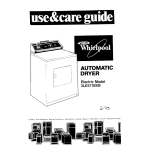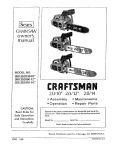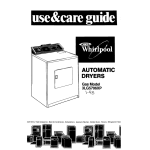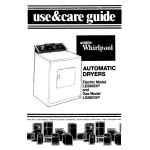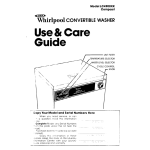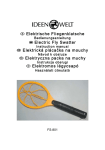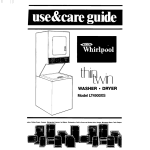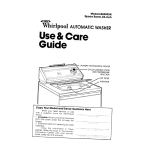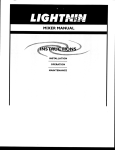Download Whirlpool LT5009XM Operating instructions
Transcript
. thFbvr7 . .,L I WASHER l DRYER Models LT5005XM LT5009XM wave Ovens, Trash Compactors, Room AH Condllloners. Dehumldlflers. Automallc Washers, Clothes Dryers. Freezers. Refngeralot-Free2 Parts and features MODE AND SERIAL NUMB1 R PLATE LINT S :REEN DRYER DRUM WASH ? CONTROLS DRYEL CONTROLS WASH L! LID LATCH OPTIC 4AL EXHAUST OUTLI LINT F IER BASKE AGITA 3R RI move the Consumer Buy Guic e label. It will be easier to 16 move before the was’ier dryer is used. YCIJ should wipe out the was’rer basket and dryer drur I with a damp cloth betore Jsing to remove dust fron storing or shipping. l Copy your Model and Serial When you need service or (call with a question, have this informatlon ready 1. Complete Model and Serial Numbers (from the plate located as shown). 2. Purchase date from sales slip. Copy this information in these spaces. Keep this book, your warranty and sales slip together in a handy place There is no warranty registration to return. Proof-of-purchase is all that is required for in-warranty service. 2 Num HXS here ComF ete Model Number Come ete Serial Number Purch, se ~~~~ Servic : Company and Telepl 3ne Number Contents Paae O3 4 Your Responsibilities.. Safety.................... Before Using Your Washer l Dryer 5 WASHER Starting Your Washer. What Happens in Each Cycle, Other Operating Instructions Cleaning the Lint Filter 10 10 DRYER Starting Your Dryer. Operating Instructions Selecting a Cycle. 11 12 13 6 8 8,~1985 Whirlpool Drying Tips. lint Screen, lint Removal Page 14 15 15 WASHER. DRYER Caring for Your Washer l Dryer, Cleaning Dryer Interior Vacation Care Winterizing If You Need Service or Assistance I. Before Calling for Assistance 2. If You Need Assistance 3. If You Need Service 4. If You Have a Problem Corporation Your responsibilities Read this”Use and Care Guide”and your “Laundry Guide” carefully for important use and safety information. You are personally responsible for installation. Have your washer /dryer installed by a qualified installer and make sure that it has been.. 1. Installed exactly according to the”lnstallation Instructions,” including.. . proper electrical supply,outlet and grounding;‘ l proper water supply, plumbing fixtures and drain;’ l proper dryer exhausting system. * 2. Installed and leveled in a room where.. l there is adequate ventilation and protection from weather; l the floor is strong enough to support the weight; l The temperature is above 45 F [7.2 C) because.. - the dryer will not operate properly at cold temperatures. -freezing temperatures can damage the washer *Refer to the”lnstallation Instructlons”for complete information. You are personally responsible for proper use of your washer /dryer. You must be sure that it is.. 1. Used only by those who understand how to operate it properly. 2. Properly maintained and used only for jobs expected of home washers and dryers. You are personally responsible for the safe use of your washer /dryer DO NOT try to service this appliance unless it is unplugged or the electrical power has been turned off. 16 16 17 17 18 18 19 19 19 Before using your THIN TWIN* washer dryer l For best washing steps before, during and drying results, you must take and after each load: some very important 1. Prepare and sort each load for washing (“Laundry Guide,” pages d-5). 2. Measure and add detergent or soap to washer (“Laundry Guide,” pages 9-10). 3. Load the washer properly (“Laundry Guide,” pages 6-7). 4. Select the water temperature, load size and cycle recommended ‘for the fabrics before starting the washer (“Use and Care Guide,” pages 6-7). 5. Add other laundry aids to the washer according to instructions (“Laundry Guide,” pages 11-13). 6. Properly sort the load for drying (“Laundry Guide,” pages 18-19). 7. Select the right drying cycle and time for the fabrics (“Use and Care Guide,” page 12-13). 8. Remove and hang or fold items lmmedlately after drying. Starting your washer 1 Measure and add detergent 2 Place sorted load In washer. 3 Start washer Select 1. LOAD a SIZE 2. 0 Turn the knob to point at a setting that describes the size of load you want to wash l The water level can be set for EX SMALL, MEDIUM or LARGE loads Select the water level that matches the load size See your “Laundry Guide” for details on load sizes. LOAD SIZES AND For best cleaning results, load must be able to move in the water Too big a load little water can cause wear tearing of load items. WATER the freely or too or DO NOT OVERLOAD WASHER. 6 Select WATER TEMPERATURES *Match the wash water temperature to the type of fabrics and soils being washed Recommended wash temperatures can be found in your “Laundry Guide: LEVELS LARGE iiis&m ‘Approxtmale fill with load I 3. A. C. Select CYCLE and WASH Start the washer Push in the Control Knob and turn it to the right. It must be pushed in and turned only clockwise Start the washer by pulling out the Control Knob. The washer will fill to the level You set with wash water of the selected temperature. After filling, the washer will agitate for the selected number of minutes TIME; B. Stop on a number in the cycle you want. The numbers are mrnutes of wash time The drawtng shows 8 minutes of agrtatron in the REGULAR HEAVY Cycle D. To stop the washer at any time, push in the Control Knob. To restart the washer, pull out the Control Knob 7 What happens in each cycle Each cycle has different agitation and spin speeds designed for different kinds of fabrics. Numbers on the dial in each cycle are the minutes of WASH agitation time. When the Cycle Control Knob is set to a number and pulled out, the washer fills before agitation and timing starts. After agitation starts, the knob turns REGULAR HEAVY Cycle A cycle for sturdily constructed fabrics that are heavily to moderately soiled. PERMANENT ff 10 4 PRESS permanent press . Cycle A special cycle with the necessary cool-down rinse which helps keep wrinkles from setting into Permanent Press and some synthetic fabrics. m KNITS/GENTLE Cycle Off 8 2 . m 2 I SOAK knlls gentle A cycle that gently washes and spins delicate items and washable knits. Wash nylon hose in a net laundry bag. PYll ,,a,, !a”.h alop Cycle Periods of agitation and soaking time help remove heavy soils and certain stains that need extra pretreatment. Use recommended amount of detergent. The SOAK Cycle should always be followed by a Wash Cycle. 8 clockwise until it points to OFF and the cycle ends. NOTE:You may hear the sound of water spraying some cycles. In some CyCles, cold water is sprayed help with the rinsing. during the spin parts of on the spinning load to L PARTIAL DRAIN [Pause) NOTE: Always I C- Pre-wash setting use cold begins rinse water for here (see pagelO) Special care is needed when soaking or pre-washing See your”laundry Guide” for proper use ot this cycle. laundry. Other operating For a rinse instructions For a drain and spin You may need an extra rinse and spin for heavily solled loads which need more detergent. (Extra detergent can require an extra rrnse ) l Push Control Knob In 9 Turn clockwrse to any.on the dial See above drawing. l Pull Control Knob out l The washer will fill to selected level; agrtate 2 mrnutes, drain and spin for agitation and spin speeds and spin Your washer can be set to dram and spin out water . Push Control Knob in . Turn clockwrse to the bar just before OFF See above drawing. l Pull Control Knob out. . The washer will dram and spin in each cycle, see pages For a soak or prewash . Use recommended For best results, use warm Water for soaking or pre-washing stained laundry Hot water can Set Stains. . . . . ‘To start soak with agitation, must point to a number Cleaning the lint 8 and 9 amount of detergent or pre-soak product. Push Control Knob in. Turn clockwrse to point at a number in the SOAK Cycle? Pull Control Knob out to start washer. When the cycle is over, add detergent for the next selected wash cycle. The SOAK Cycle should always be followed by a Wash Cycle. Important: See additional care intormation on page 7 of your “Laundry Guide!’ the Cycle Control Knob in the SOAK Cycle. filter Water runs through the lint filter whenever the washer agitates. Check it often to make sure it’s clean and is filtering at its best. To remove it for cleaning, press the release and pull straight out. Instructions for cleaning are printed on the bottom of the filter. II Starting your dryer Before starting your dryer, be sure laundry is sorted and loaded properly [see your “Laundry Guide”). Be sure the door is tightly closed. 1. Select CYCLE 3. 2. and TIME Turn the Control Knob either point to the time setting you the cycle you want. Push the START Button way to Want In To stop and restart the dryer The dryer will start tumbling you push the START Button. 4 l Changing when a setting The setting can be changed at any time by turning the Control Knob to a new setting. To stop. open the door [or turn the Control Knob to OFF). To restart, close the door and push the START button. The Cycle Control Knob should point to OFF when the dryer is not in use. 11 Operating instructions The automatic cycles The automatic cycles allow you to select the degree of dryness you prefer for the clothes being dried. The Control Knob moves and stops several times until the load reaches the dryness setting you selected. Then the knob automatically moves to OFF and tumbling stops. Use AUTOMATIC REGULAR to dry heavy and mediumweight cotton items. The load tumbles without heat during the last 5 minutes. This helps make the load easier to handle I Use AUTOMATIC PERMANENT PRESS to dry m permanent press, knits and other synthetic fabrics. The load tumbles without heat during the last 10 minutes. This helps keep wrinkles from setting in. I’bneddxying Use the TIMED DRYING Cycles for any load you want to dry by time. For example: small loads, large bulky items, items to be fluffed or dusted. l l Turn the Control Knob to the number of minutes you want - from 10 to 50. The last 5 minutes of this cycle are without heat - a cool-down time. This helps make the load easier to handle. 12 For the first few loads, set the Control Knob to point to an* in either automatic cycle. When the dryer stops, feel the dried items. l l If items are drier than you like, use a setting to the right of the*the next time.._ v&l -......-. lnnd .---. I -- firv -’ I n- kihilnr If items are not as dry as you like, use a settina to the left of the * the next time V&J dry a similar load Selecting a cycle TYPE OF LOAD SUGGESTED CYCLE COllONS - LINENS EXTRA HEAVY- Bedspreads, mattress pads, quilts HEAVYWEIGHT FABRICS-Towels, jeans, corduroys, workclothes .. .......... ..... .. . ... MEDIUMWEIGHT COTTONS - Sheets, pillowcases, cotton underwear, diapers LIGHTWEIGHT COTTONS - Batistes, organdies, lingerie AUTOMATIC REGULAR PERMANENT PRESS, SYNTHETICS AND BLENDS HEAVYWEIGHT FABRICS-Work clothes, jackets, raincoats ,..,._,,, ..,........, MEDIUMWEIGHT FABRICS-Shirts, play clothes, sheetsslacks, LIGHTWEIGHT FABRICS - Lingerie, blouses, dresses AUTOMATIC PERMANENT PRESS KNITS HEAVYWEIGHT-Cottons, rayons, blends, T-shirts, slacksshirts .,..,,........................,..,.... LIGHTWEIGHT- Synthetics (polyester, acrylic, etc.] and blends, lingerie, blouses, dresses AUTOMATIC PERMANENT PRESS LIGHTWEIGHT AND DELICATE FABRICS Sheer Curtains (2 or 3 panels) Gauze,lace,etc. .,,..,..,,..,....,...............,. AUTOMATIC PERMANENT PRESS RUBBER, PLASTIC, HEAT-SENSITIVE FABRICS FOAM RUBBER- Pillows, bras, stuffed toys PLASTIC-Shower curtains, tablecloths OLEFIN, POLYPROPYLENE, SHEER NYLON AIR 20 MINS. 20 MINS. 15-20 MINS. 13 Drying tips Mixed TI le dryer does not heat when the Control Knob is set on AIR. This setting can be used to fluff bedding, plastic tablecloths, foam rubber pillows, stuffed toys, sneakers, etc. loads When drying a load with different kinds and weights of fabrics, use the cycle suggested for the lightest fabrics. When the dryer stops, remove dry items and reset the control. To help reduce wrinkling, take the load from the dryer as soon as tumbling stops.This is very important for permanent press, knits and other synthetic fabrics. TUMBLE PRESS Setting The TUMBLE PRESS setting removes wrinkles from dry clothing such OS items that may hove been packed in a suitcase, closet, or items not removed from the dryer. The load will tumble in heated air for 10 minutes. The heat shuts off and the dryer continues to tumble the load for 5 more minutes. For best results, TUMBLE PRESS only a few items at a time. Put them on hangers or told them as soon as the dryer stops. 14 Drying times Drying times will vary depending on. l amount of moisture in the clothes. 9 type and weight of the fabric. l size of the load. l room temperature around the dryer. l temperature of the wash rrnse water. l amount of lint in the lint screen. l dryer temperature selection. See page 19 in your”Laundry Guide” for more information Lint screen Clean increase the lint screen before each load. A screen drying time and may be a FIRE HAZARD. The lint screen IS Inside the dryer pull drum, on the Dack wall I. Use tno finger holes 73 pull ?‘-te III’ screen WARNING: DO NOT run the dryer with the lint screen loose, damaged or missing Doing so can cause overheating, can damage fabrics and can be a FIRE HAZARD. by lint c an blocked 2. Lightly squeeze the boay S.S shown while 5. LCOI; :Irv ,?f: the V’OU’ ilpiqeF; .. Squeeze body; pull cover off. DO NOi rinse or wash the screen. Wet lint is hard to remove. 4. Replace the cover on the body of the lint screen 5. Push the lint screen straight back in until It clicks into place Lint removal Lint can gather inside the dryer and create a fire hazard This lint should be removed every 2 to 3 years, or more often, depending on dryer usage. Cleaning should be done only by a qualified 1. Remove bock panel from dryer 2. Avoid touching thermostats, wires, terminals and heater box. 3. Remove lint from shaded area - see art -- with a soft brush or vacuum cleaner. 4. Replace back panel Reconnect exhaust duct, etc Level the washer/dryer Avoid electrical shock hazard - unplug power supply cord or turn off electrical power. l Avoid injury or damage-do not put hands inside cabinet. . Metal edges may be sharp. l Make sure dryer is cool. service person. Thermostats ( ‘j Heaty Fox l Heat Elemekt Termmals 15 Caring for your washer l dryer Sharp or heavy objects should never be put on or in the washer or dryer. Check pockets for bolts, nuts, etc. When not washing, keep both water faucets turned off. This takes the pressure off the water inlet valve and hoses. Some pretreatment products can damage dials, consoles and finish. Do not use these products on or near your washer or dryer. Cleaning dryer interior Never soak l soak l soak l soak l use the washer to... for more than 2 hours with chlorine bleach. with vinegar or other acids. or store urine soaked clothes. Never leave or store wet, damp or dry laundry in your washer or dryer. Garments which contain unstable dyes, such a denim blue jeans or brightly colored cotton items, may discolor the dryer interior. If the interior is discolored, clean with one of the following methods to avoid staining later load items. Atter washing, use a soft dry cloth to wipe the outside and inside dry. leave washer lid up until the basket is dry. Wipe up all spills. Spills allowed to remain may dull or damage the finish. Remove loose and sharp objects from pockets and cuffs before washing or drying - pins, buckles, etc. Close metal zippers. 16 Powdered laundry detergent and very warm water Make a paste with detergent and very warm water. Apply paste to a soft cloth and scrub area until all excess dye is removed. Wipe thoroughly with a damp cloth. Tumble a load of rags. -ORliquid spray household cleaner Spray on stained area. Rub with a cloth until all excess dye is removed. Tumble a load of rags. Vacation care 1. Turn off bott take pressu and hoses 2. Unplug pov turn off elec 3. Clean lint s( Nater faucets to L: off inlet valves ‘?r supply cord or rlcal power supply reen and lint filter Winterizing Install and store your washer) dryer where It ion’t freeze Because some water stays In the washer, freezing can d Image it If your washer; dur ng freezing weatl er, winterize It dryer IS stored or moved 1. Shut off both water 2. Put (:I quart of automotXile-type antlfreeze in the basket faucets Disconnect and drain water inlet hoses To use the washer 1. Flush water again.. pipes and hoses. 2. Reconnect water let hoses . 3. Run washer on a drain and spin settlng (see page 10) for a bout 30 seconds to mix antifreeze and water 1. To clean out antifreeze, run washer through a complete cycle with a cup of detergent 3. Turrl on both water faucets In- 17 If you need service or assistance, we suggest you follow these four steps: 1, Before calling for assistance... Make sure that the Cycle Control Knob is pointing to a number in the cycle. Make sure the drain hose is higher than the water level in the washer. If it isn’t... l The washer may seem to be draining during wash and rinse cycles. l Water can siphon out. (See “lnstallation Instructions:‘) l Performance problems often result from little things you can find and fix yourself without tools of any kind. If your washer does not fill: l Is the power supply cord plugged into a live circuit with the proper voltage? l Are both water faucets open? l Have you checked your home’s main fuses or circuit breaker box? l Are the water supply hoses kinked? l Is the Cycle Control Knob set and pulled out? If your washer does not spin: l Is the lid closed? l Is the power supply cord plugged into a live circuit with the proper voltage? Have you checked your home’s main fuses or circuit breaker box? If your washer drains at the wrong time: l The drain hose should be at least 28 inches above the floor and secured. l The drain hose should not fit tightly in the drain pipe. 18 l If your washer stops during the permanent press cycle: l Remember, the washer will stop for about 2 minutes after the partial drain during the cool-down period in this cycle. If your dryer does not run or heat: Is the power supply cord plugged into a live circuit with the proper voltage? l Is the door closed tightly? l Did you push START? l Have you checked your home’s main fuses or circuit breaker box? l The AIR setting is without heat. l The last minutes of heat settings are without heat. See page 12. If drying times seem too long: l l l l Is the lint screen clean? Is the room cold? See page 14 of this book and page 19 of your “Laundry Guide:’ 2. If you need assistance*... Call Whirlpool COOL-LINE” service assistance telephone number. Dial free from: Continental U.S. . (800) 253-1301 Michigan . . . . . . . . (800) 632-2243 Alaska 6 Hawaii (800) 253-1121 and talk with one of our trained Consultants. The Consultant can instruct you in how to obtain satisfactory operation from your appliance or, if service is necessary, recommend a qualified service company in your area. 3. If you need service*... r!Y chised TECH-CARE ” 7ECf/-CARE Service CompaFRANCHISEDSEIVICE j nies, TECH-CARE service technicians are trained to fulfill the product warranty and provide after-warranty service, anywhere in the United States. To locate TECH-CARE service in your area, call our COOL-LINE service assistance telephone number (see Step 2) or look in your telephone directory Yellow Pages under: 4. If you have a problem*... Call our COOL-LINE service assistance telephone number (see Step 2) and talk with one of our Consultants, or if you prefer, write to: Mr. Stephen E. Upton Senior Vice President Whirlpool Corporation Administrative Center 2000 US-33, North Benton Harbor, Ml 49022 *If you must call or write, please provide: model number, serial number, date of purchase, and a complete description of the problem. This information is needed in order to better respond to your request for assistance. FSP is a registered trademark of Whirlpool Corporation for quality parts Look for this symbol of quality whenever FSP you need a replacement part @ tor your Whirlpool appliance. FSP replacement parts wll fit right ond work right, because they are mode to the some exacting specihcations used to build every new Whirlpool appliance. 0 19 I II Making Part No. 693016 a1985 Whirlpool Corporation your world a little easier. Printed in U.S.A.





















